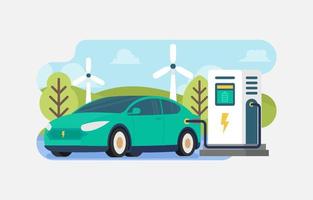EV charging infrastructure offers numerous opportunities for businesses and communities. These benefits include:
EVs must be available to a diverse population, including sizable groups who lack home charging and those traveling long distances. Prioritizing equity with EV charging station placement, education initiatives, and incentive programs will help close gaps in EV accessibility.
Reduced Carbon Footprint
If the United States is to reach its zero-emissions goals by 2025, it will need more than 1.2 million public charging stations. Existing state incentives and VW funds can cover only half of this gap; additional public resources and private investment will be needed to accelerate EV charger deployment through 2025.
Investing in EV charging infrastructure is an opportunity to reduce GHG emissions and create jobs that help communities reach their climate goals. It requires a holistic approach that combines political and locational intelligence with equipment and site lease terms, integrated power agreements, and operational savvy to optimize climate and equity outcomes.
Public-sector real estate portfolios present an unrivaled opportunity to attract public-private partnerships to build, finance, and operate EV charging infrastructure. With the value of these assets acknowledged, partners can align on technical and business models to accelerate project delivery timelines, deliver cost-effective solutions and meet environmental and social objectives.
Increased Sales
Electric vehicle charging products and services attract customers and create revenue for businesses. They can be located where people already congregate, such as workplaces, restaurants, and shopping malls. They can also be built at new locations, such as public parking lots or driveways.
Currently, most charging companies build and operate public charging stations with either business models that sell electricity directly to consumers or through service fees for station installation, operation, and maintenance. However, more charging stations are needed to profit under either model.
The Bipartisan Infrastructure Law includes $5 billion in formula funding to support states building a coast-to-coast network of 500,000 EV chargers, making it easy for Americans to drive electric long distances. This investment will increase confidence that drivers can find a place to charge, jump-start private investments in EVs and charging infrastructure, and help grow American jobs—including high-quality manufacturing jobs in the U.S. for components and equipment to build, operate and maintain these facilities. It will also expand opportunities for disadvantaged communities to benefit from economic and environmental outcomes from this significant new investment in their futures.
Increased Customer Satisfaction
Public charging stations can level the economic playing field for EV adoption and accelerate the rate of progress toward carbon goals. However, a gap persists between the number of chargers installed and those needed to reach EV ownership goals. This gap will only be closed if the country commits to holistic front-end planning and investment in EV charging networks that are equitable and cost-effective for all.
Currently, the nation’s charging station network struggles with inconvenient or unreliable availability and accessibility. According to a McKinsey survey, those experiences frustrate EV drivers, who often report low speed and difficulty finding working chargers. They also can be hindered by a range of pricing systems that require memberships or differ in price by minute or kilowatt hour.
Cities, counties, and states that invest in EV charging infrastructure can create attractive, easy-to-use networks. They can leverage their land sites and facilities to attract private partners with technical expertise and third-party capital, streamline policies and permit processes, and establish consistent leasing terms for land or buildings.
Increased Market Resilience
EVs, equipped with bidirectional charging technology, are the ideal solution to help mitigate the effects of severe weather events. They can provide backup power to keep community centers, medical offices, and disaster shelters running without the need for special shipments of fuel or generators.
Investing in public EV charging infrastructure can also create well-paying jobs across multiple sectors. For example, EV charging stations require various skills, from manufacturing and installation to data management and hardware hookups. As a result, the Federal government has set up funding programs to support domestic production and to build out a nationwide network of EV charging.
EV-charging infrastructure is critical to thoroughly preparing communities to transition to a zero-carbon energy system. The industry must prioritize EV charging station placement based on four key factors: where people live, work, shop/play, and fuel their vehicles. This approach will ensure that future EV drivers can access reliable charging solutions regardless of where they are on the road. This will also help address gaps in existing EV charging networks that persist in many areas, especially for disadvantaged populations.
Increased Brand Recognition
EV chargers offer opportunities to build brand awareness and reputation. In addition to supporting the EV market, they can also be used to attract and retain customers by promoting environmentally and socially-conscious behaviors. For example, many consumers are more likely to purchase an EV if their workplaces or apartments have charging stations. Additionally, customers may be more willing to spend more at a business that offers EV charging stations, especially if they can stay longer to charge their vehicle.
In the near term, making EVs more competitive requires differentiated taxation and purchase subsidies based on environmental performance, decarbonization of electricity generation, and deployment of recharging infrastructure and manufacturing sustainable batteries. Further, the success of EVs will depend on the availability of convenient public and workplace charging points that make it easier for people to adopt a more environmentally friendly transport choice.




